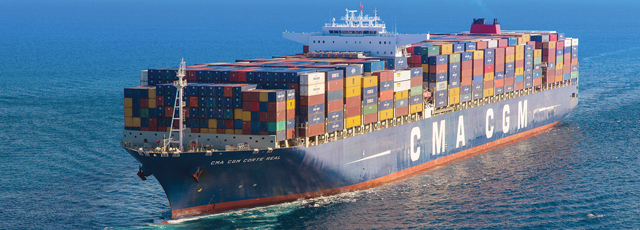Ocean Carriers Struggle With Pricing Due to Data Gaps, Consultant Says
 Tim Rue/Port of Long Beach
Tim Rue/Port of Long BeachThis story appears in the March 23 print edition of Transport Topics.
Ocean carriers continue to struggle with cargo pricing because they lack shipment-specific information for the ocean, trucking and terminal components of their international moves, an industry official said.
Ocean carriers “really are multimodal providers” and don’t just simply move freight between ports, James Blaeser, a consultant at Alix Partners, said on a March 13 conference call.
“It is critical to capture data at the container level rather than the voyage level,” he said. “The shipping industry has never been accused of being on the cutting edge of technology.”
Ocean carriers’ pricing matters to trucking because companies such as Maersk Line and CMA CGM determine overall rates for both the international and domestic portions of most container shipments moving inland from U.S. ports.
What ocean carriers in general fail to do, Blaeser said, is integrate information from multiple sources, including U.S. trucking and terminal components, the ocean voyage and the overseas trucking and terminal portions.
Ocean carriers overlook cost factors such as shipment detention, demurrage expense and shifts between intermodal and over-the-road trucking in the United States as well as fuel consumed by refrigeration units, Blaeser said.
The pricing systems for ocean carriers and freight forwarders also are relying too much on paper documents and data that are in too many different formats, said a report from David Ross, an analyst at Stifel Nicolaus, which hosted the conference call.
“Carriers or forwarders are acting off what they believe to be a sufficient costing model, but as is shown in their financial results, they don’t really understand what it costs to handle a shipment,” Ross’ report said.
Esben Christensen, another Alix Partners consultant, agreed that information gaps are holding back ocean carriers from improving rates and making more progress in their financial recovery.
Using a group of 15 publicly traded carriers that accounts for about two-thirds of global container freight, Christensen said those operators achieved higher earnings before interest and taxes last year of $7.85 billion, or about 40% better than 2013.
However, Christensen noted that 2014 profit margins on a per-shipment basis hovered around 5%, or about half of what they were before the recession began.
The modest overall improvement in ocean carrier financial performance masks a growing gap between “haves and have-nots,” he said, as companies such as Maersk improve profitability while other companies’ losses mount.
The consultants also projected 2015 world container cargo growth and gauged the level of overcapacity in ocean shipping trades due to overbuilding of larger ships.
International freight market growth will continue at about a 6.4% pace this year over 2014, helping to sustain trucking demand, Blaeser said, matching last year. The 6.4% growth matches the annual improvement pace from 2014 compared with 2013.
However, the growth pace that is being held back by sluggish economies in Europe and elsewhere is sharply lower than the prerecession pace of 10% or greater annually, he noted.
The total available container capacity of ocean carriers will continue to be 6% to 8% higher than the demand to ship cargo, Blaeser said.
The widening gap is part of a longer trend, he noted, that has left the growth in container shipment supply above demand to handle that freight in eight of the past 10 years.
Ross noted that a portion of the ocean carriers’ improved financial fortunes relates to divestiture of logistics and port terminal assets that are not part of their core shipping business.
Among the recent moves was the announcement by Singapore-based Neptune Orient Lines to sell its APL Logistics unit for $1.2 billion to Tokyo-based airfreight operator Kintetsu World Express Inc. Neptune Orient’s primary business is international ocean shipping.
Christensen said “that trend is going to continue to grow” as ocean carriers continue to concentrate on shipping services and other cost-reduction efforts such as managing capacity through vessel-sharing alliances.

